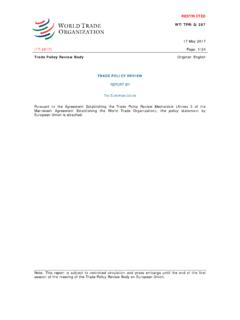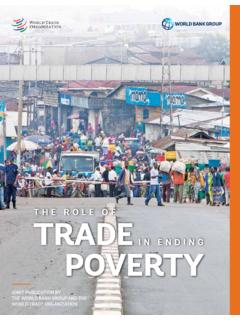Transcription of Digitalization in Transport and Logistics Services: --- A ...
1 Digitalization in Transport and Logistics Services: ---A Case for Data Flows Ruosi ZhangGeneva, 9 September 2020 Digitalization in Transport and Logistics Services While Transport services require physical delivery, Digitalization is transforming the sector along the Transport supply chain: Vehicle/ship design; Infrastructure: road, bridges, tunnels, rail, ports, terminals; Transport operation ( capacity allocation, cargo management, shipment tracking and tracing, customer services, etc.) Intermediary services; Supporting services: warehousing, monitoring and inspection; Maintenance and repair of Transport equipment; Information and documents transmission among multi-players (shippers, shipping lines, port authority, the Customs, terminal operators, etc.)Common features of digital trends Higher level of automation; Better and broader connectivity; Main digitaltechnologiesand solutions: Internet of Things, cloud computing, big data analytics, automation and robotics, artificial intelligence; Digital platforms become a new business model, which enable innovative Transport services or more efficient supply of services and increase tradability of services; Data-drivenapproach become dominant for both businesses and regulators.
2 Digital synergies between Transport / Logistics services and other service sectors: digital transformation of Transport and Logistics services relies on the support of other services, but also boosts the latter s advances, such as: telecom, CRS, construction and engineering, energy, environment, and other business in road Transport Higher levels of automation: platooning, autonomous vehicles Intelligent Transport System (ITS): wide deployment of road-side and in-vehicle sensors combined with Big Data analytics allows real-time and fine-grained tracking so as to enable better management of vehicles and loads. Digital freight brokerage services: load -matching platforms, Uber freightUber freight, a digital load -matching platform connecting carriers and shippersDigitalization in maritime Transport Online booking and online cargo management Tracking and tracing of shipments Routs optimization Autonomous vesselsTradeLens, a blockchain-enabled digital container Logistics platform jointly launched by Maersk and IBMD igitalization in rail Transport Autonomous trains Signalling and traffic management Digital train control Digital platforms for predictive maintenance and reparation E-ticketingDigitalization in urban Transport Digital technologies ( AI, IoT, automation, Big Data Analytics, etc.)
3 Provides possibility to address chronical urban Transport problems, traffic jams; lack of choice for consumers; inefficient utilization of vehicles and space; pollution; collection and data analytics help better identify causes of problems and find solutions;oData-driven new public Transport services: Via Van, US-German joint venture, on-demand, dynamic, data-driven public mobility global reach, distinguished from ride-hailing and on-demand transit, relying on public-private partnership;oDigital platform enabled innovations, ride-hailing and car-sharing: Uber, Didi; bike/scooter sharing Mobility as a Service (MaaS) Digitalization in Logistics servicesData at the centre of Transport and Logistics servicesDataAutomation in Transport operationInformation and document transmission Smart Transport infrastructureDigital platforms The digitization of Transport is about creating new paradigms in the visualization and capitalization of data, of a given system and to use that knowledge to build a more optimized and maintainable infrastructures.
4 -McKinseyDigital transformation in Transport and Logistics : Policy implications Data is crucial not only for the operation of business, but also for governance and policy-making in the age of Digitalization ; Some other issues also become prominent: interoperability between different systems, harmonization of individual Digitalization initiatives, standardization, safety, cybersecurity, etc. Synergies with other sectors require a holistic digital strategy to build a supportive ecosystem; Disruptive effects of Digitalization on incumbent services and service suppliers require balancing policies and regulations; Policies and regulatory framework should foster innovations which are not only sources of competitiveness, but also beneficial to public















